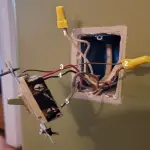Last Updated on 11 months by Francis
The phenomenon of electromagnetic induction occurs when a changing magnetic field induces an electromotive force (EMF) in a nearby conductor, such as a coil of wire. This process is key to understanding many electrical devices, from generators and transformers to motors and solenoids. In this discussion, we will explore how the EMF can be induced in a coil and the factors that affect its strength.
Contents
Understanding Electromagnetic Fields (EMF) and Induction
Before we dive into the ways to induce EMF in a coil, let’s first understand the basics of electromagnetic fields and induction. Electromagnetic fields are produced by the movement of electric charges. When an electric charge moves, it creates a magnetic field perpendicular to the direction of the charge’s motion. This magnetic field can then induce an electric current in a nearby conductor through a process called induction.
Faraday’s Law of Induction
Faraday’s law of induction describes how a changing magnetic field can induce an electric current in a conductor. This law states that the magnitude of the induced EMF is directly proportional to the rate of change of the magnetic field. This means that the faster the magnetic field changes, the greater the induced EMF will be.
Example of Faraday’s Law of Induction
To better understand Faraday’s law of induction, let’s consider an example. Imagine we have a coil of wire and a magnet. If we move the magnet towards the coil, we create a changing magnetic field. This changing magnetic field will induce an electric current in the coil. If we move the magnet away from the coil, we again create a changing magnetic field that will induce an electric current in the opposite direction.
Ways to Induce EMF in a Coil
Now that we understand the basics of induction, let’s explore the different ways to induce EMF in a coil.
1. Moving a Magnet
One of the most common ways to induce EMF in a coil is by moving a magnet relative to the coil. As we saw in the previous example, moving a magnet towards or away from a coil creates a changing magnetic field that induces an electric current in the coil.
2. Changing the Current in a Nearby Coil
Another way to induce EMF in a coil is by changing the current in a nearby coil. When the current in a nearby coil changes, it creates a changing magnetic field. This changing magnetic field can then induce an electric current in the coil.
3. Rotating a Coil in a Magnetic Field
Rotating a coil in a magnetic field is another way to induce EMF in a coil. As the coil rotates, the magnetic field passing through the coil changes, inducing an electric current in the coil.
4. Oscillating a Magnetic Field
Oscillating a magnetic field is another method to induce EMF in a coil. By rapidly changing the magnetic field, we can induce an electric current in the coil.
5. Using Electromagnets
Finally, we can induce EMF in a coil by using an electromagnet. An electromagnet is a coil of wire with a current running through it, creating a magnetic field. By changing the current in the electromagnet, we can induce an electric current in a nearby coil.
FAQs – How can the emf be induced in a coil?
What is an emf and how is it induced in a coil?
An electromotive force (emf) is the voltage or electrical potential difference produced between two points in a circuit. It is induced in a coil by a change in the magnetic flux passing through the coil due to the movement of a magnetic field. The coil must be within the magnetic field and be positioned perpendicular to the magnetic field lines for maximum flux linkage.
What are the factors affecting the magnitude of the induced emf?
The magnitude of the induced emf is affected by several factors, including the strength of the magnetic field, the number of turns in the coil, the speed of the magnetic field changes, and the area of the coil. The higher the magnetic field strength, the more turns that are wound on the coil, and the faster the changes in the magnetic field, the higher the induced emf will be. Similarly, the area of the coil will also affect the magnitude of the induced emf.
What is Faraday’s Law of electromagnetic induction?
Faraday’s Law of electromagnetic induction states that the amount of emf induced in a coil is proportional to the rate at which the magnetic field is changing with respect to time. The equation for Faraday’s Law is written as emf = -dΦ/dt, where emf is the electromotive force, Φ is the magnetic flux, and dt is the time interval.
How can we increase the induced emf in a coil?
To increase the induced emf in a coil, we can increase the strength of the magnetic field, increase the number of turns in the coil, increase the speed at which the magnetic field changes, or increase the area of the coil. Another way to increase the induced emf is by using a ferromagnetic core placed inside the coil, which can enhance the magnetic field strength and flux linkage, resulting in a higher induced emf.
What are the practical applications of induced emf in coils?
Induced emf in coils has many practical applications, such as in generators, transformers, motors, and sensors. Generators and transformers use induced emf to convert mechanical energy into electrical energy, while motors use it to convert electrical energy into mechanical energy. Induced emf in coils is also used in sensors to detect changes in magnetic fields, such as in magnetic intrusion detectors and metal detectors.





